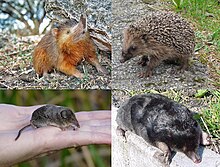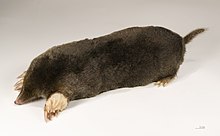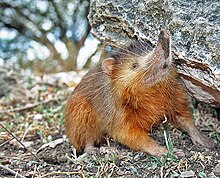Eulipotyphla
| Eulipotyphla Temporal range:
| |
|---|---|

| |
| Clockwise from upper left: a solenodon, hedgehog,[a] mole and shrew | |
| Scientific classification | |
| Kingdom: | Animalia |
| Phylum: | Chordata |
| Class: | Mammalia |
| Magnorder: | Boreoeutheria |
| Superorder: | Laurasiatheria |
| Order: | Eulipotyphla Waddell et al., 1999 |
| Families | |
| |
| Synonyms | |
| |
Eulipotyphla (/ˌjuːlɪpoʊˈtɪflə/, which means "truly fat and blind"[1]) is an order of mammals suggested by molecular methods of phylogenetic reconstruction, and includes the laurasiatherian members of the now-invalid polyphyletic order Lipotyphla, but not the afrotherian members (tenrecs, golden moles, and otter shrews, now in their own order Afrosoricida). Lipotyphla in turn had been derived by removing a number of groups from Insectivora, the previously used wastebasket taxon.
Eulipotyphla comprises the hedgehogs and gymnures (family Erinaceidae, formerly also the order Erinaceomorpha), solenodons (family Solenodontidae), the desmans, moles, and shrew-like moles (family Talpidae) and true shrews (family Soricidae). True shrews, talpids and solenodons were formerly grouped in Soricomorpha; however, Soricomorpha has been found to be paraphyletic, since erinaceids are the sister group of shrews, and they are more closely linked to the Carnivora order; (such as cats, dogs, bears, skunks, badgers, etc.).[2][3][4]
It is the sister clade of Scrotifera; together, they make up Laurasiatheria.
Classification[]



- Order Eulipotyphla (= 'Lipotyphla' - Afrosoricida = 'Erinaceomorpha' + 'Soricomorpha')
- Family Erinaceidae[7]
- Subfamily Erinaceinae: hedgehogs
- Subfamily Galericinae: gymnures or moonrats
- Family Soricidae[8]
- Subfamily Crocidurinae: white-toothed shrews
- Subfamily Soricinae: red-toothed shrews
- Subfamily Myosoricinae: African white-toothed shrews
- Family Talpidae[9]
- Subfamily Talpinae: Old World moles and desmans
- Subfamily Scalopinae: New World moles
- Subfamily Uropsilinae: shrew-like moles
- Family Solenodontidae: solenodons
- † Family Nesophontidae: extinct West Indian shrews
- † Family Amphilemuridae
- † Family Nyctitheriidae
- † Family
- Family Erinaceidae[7]
Family-level cladogram of modern eulipotyphlan relationships, following Roca et al. and Brace et al.:[3][10]
| Eulipotyphla |
| ||||||||||||||||||||||||
The upper and lower basal subclades within the tree are the suborders Solenodonota and Erinaceota, respectively.[10] These two branches are estimated to have split ~72-74 million years (Ma) ago.[10][5][6] The Nesophontidae and Solenodontidae are thought to have separated roughly 57 Ma ago.[10] Split times for talpids vs. soricids plus erinaceids, and for soricids vs. erinaceids, have been estimated at around 69 Ma and 64 Ma ago, respectively.[11]
Notes[]
- ^ Either a European hedgehog or a northern white-breasted hedgehog
References[]
- ^ Hassan, Mo (2009-10-11). "British Wildlife: N". The Disillusioned Taxonomist blog. Retrieved 2015-11-26.
- ^ Douady, C. J.; Chatelier, P. I.; Madsen, O.; de Jong, W. W.; Catzeflis, F.; Springer, M. S.; Stanhope, M. J. (October 2002). "Molecular phylogenetic evidence confirming the Eulipotyphla concept and in support of hedgehogs as the sister group to shrews". Molecular Phylogenetics and Evolution. 25 (1): 200–209. doi:10.1016/S1055-7903(02)00232-4. PMID 12383761.
- ^ a b Roca, A. L.; Bar-Gal, G. K.; Eizirik, E.; Helgen, K. M.; Maria, R.; Springer, M. S.; O'Brien, S. J.; Murphy, W. J. (2004-06-10). "Mesozoic origin for West Indian insectivores". Nature. 429 (6992): 649–651. Bibcode:2004Natur.429..649R. doi:10.1038/nature02597. PMID 15190349. S2CID 915633.
- ^ Bininda-Emonds, O. R. P.; Cardillo, M.; Jones, K. E.; MacPhee, R. D. E.; Beck, R. M. D.; Grenyer, R.; Price, S. A.; Vos, R. A.; Gittleman, J. L.; Purvis, A. (2007-03-29). "The delayed rise of present-day mammals". Nature. 446 (7135): 507–512. Bibcode:2007Natur.446..507B. doi:10.1038/nature05634. PMID 17392779. S2CID 4314965.
- ^ a b de Lazaro, Enrico (19 March 2018). "Solenodon Genome Sequenced". . Retrieved 2019-06-23.
- ^ a b Grigorev, K.; Kliver, S.; Dobrynin, P.; Komissarov, A.; Wolfsberger, W.; Krasheninnikova, K.; Afanador-Hernández, Y. M.; Brandt, A. L.; Paulino, L. A.; Carreras, R.; Rodríguez, L. E.; Núñez, A.; Brandt, J. R.; Silva, F.; Hernández-Martich, J. D.; Majeske, A. J.; Antunes, A.; Roca, A. L.; O'Brien, S. J.; Martínez-Cruzado, J. C.; Oleksyk, T. K. (2018). "Innovative assembly strategy contributes to understanding the evolution and conservation genetics of the endangered Solenodon paradoxus from the island of Hispaniola". GigaScience. 7 (6): giy025. doi:10.1093/gigascience/giy025. PMC 6009670. PMID 29718205.
- ^ Kim, N.H.; Lim, S.J.; Chae, H.M.; Park, Y.C. (2017). "Complete mitochondrial genome of the Amur hedgehog Erinaceus amurensis (Erinaceidae) and higher phylogeny of the family Erinaceidae". Genetics and Molecular Research. 16 (1). doi:10.4238/gmr16019300. PMID 28198504.
- ^ Dubey, S.; Salamin, N.; Ohdachi, S.D.; Barrière, P.; Vogel, P. (2007). "Molecular phylogenetics of shrews (Mammalia: Soricidae) reveal timing of transcontinental colonizations". Molecular Phylogenetics and Evolution. 44 (1): 126–137. doi:10.1016/j.ympev.2006.12.002. PMID 17267241.
- ^ He, K.; Shinohara, A.; Helgen, K.M.; Springer, M.S.; Jiang, X.-L.; Campbell, K.L. (2017). "Talpid Mole Phylogeny Unites Shrew Moles and Illuminates Overlooked Cryptic Species Diversity". Molecular Biology and Evolution. 34 (1): 78–87. doi:10.1093/molbev/msw221. PMID 27795230.
- ^ a b c d Brace, S.; Thomas, J. A.; Dalén, L.; Burger, J.; MacPhee, R. D. E.; Barnes, I.; Turvey, S. T. (2016). "Evolutionary History of the Nesophontidae, the Last Unplaced Recent Mammal Family". Molecular Biology and Evolution. 33 (12): 3095–3103. doi:10.1093/molbev/msw186. PMID 27624716.
- ^ Springer, M. S.; Murphy, W. J.; Roca, A. L. (2018). "Appropriate fossil calibrations and tree constraints uphold the Mesozoic divergence of solenodons from other extant mammals". Molecular Phylogenetics and Evolution. 121: 158–165. doi:10.1016/j.ympev.2018.01.007. PMID 29331683.
- Eulipotyphla
- Mammal orders
- Extant Eocene first appearances
- Eulipotyphla stubs
